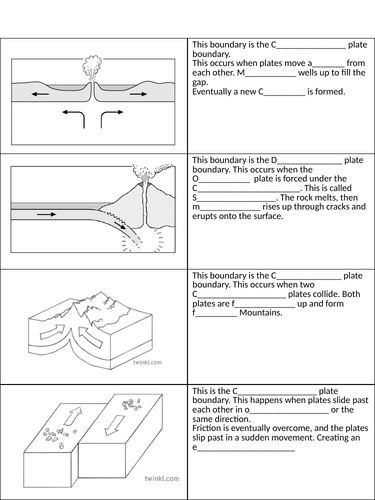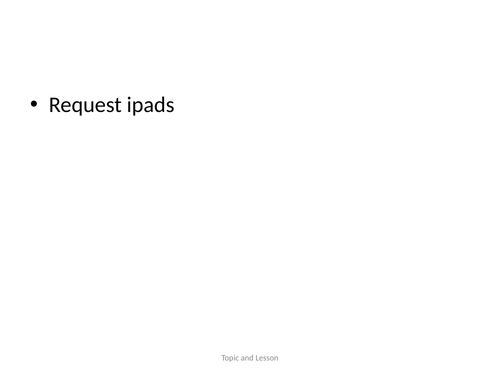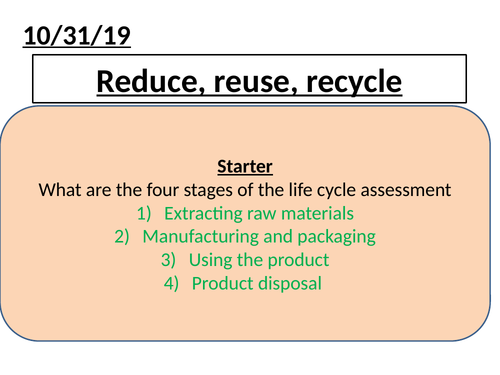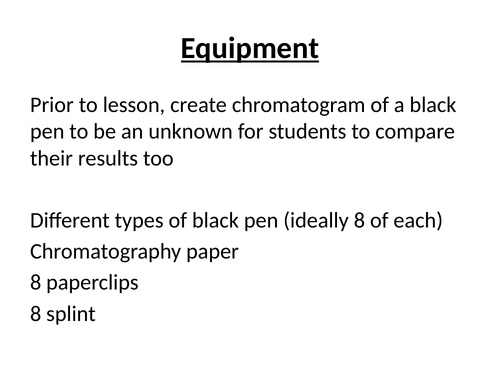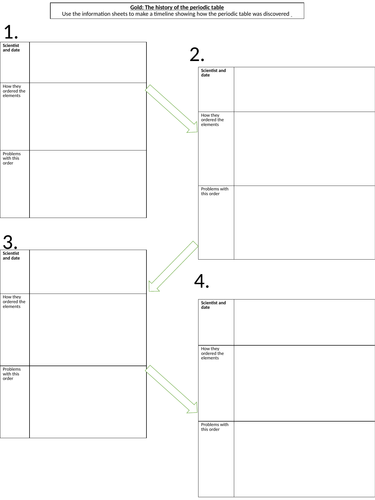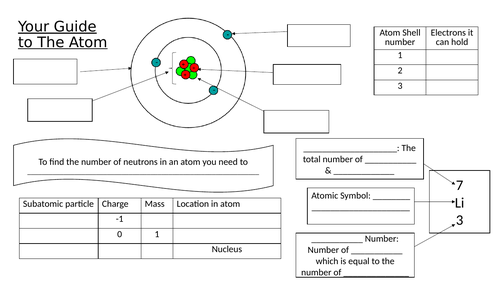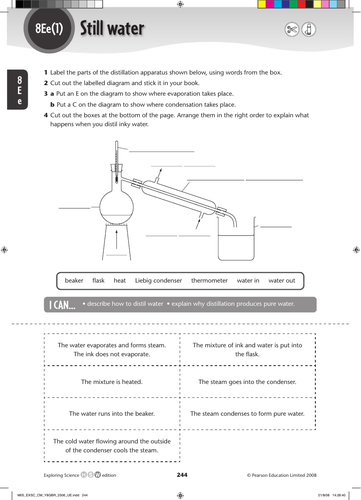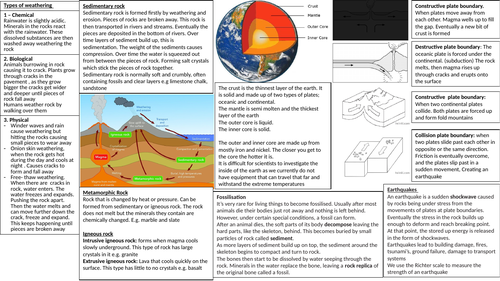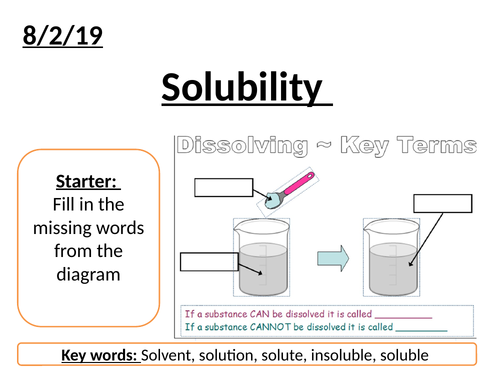
124Uploads
37k+Views
9k+Downloads
Chemistry

Plate boundaries - differentiated tasks
Low ability - fill in the gaps activity with the first letter of each missing word
Middle ability - fill in the gaps
High ability - explain themselves

Fractional distillation KS3
Aimed at a mixed ability year 8 class
Starter: work out the link between the pictures
Main: Explain what crude oil is and what fractional distillation is
Watch video, answer questions, green pen mark questions
Complete level 1/2/3 worksheets explaining fractional distillation
Extension: research task linking SMSC and crude oil
Plenary: What problems would we encounter if we banned all crude oil now

C12.6 reduce reuse recycle
Aimed at low ability students, targets of level 4s
Starter: recap on stages of LCA
Main: link up key words to defintions for three R’s
Pictures on board of different items, what are they made of ? can they be recycled?
Discuss three R’s with students
using textbooks students then make an information sheet using the success criteria on the powerpoint
Plenary: 6 mark question about the the three r’s

Chromatography KS3
Aimed at a mixed ability year 8 class
Starter: summaries what separation techniques students have learnt about so far
Main: Define and explain chromatography
Show students a chromatogram and discuss what we can learn from it
Practical: carry out an investigation to see who wrote the note, work sheet to complete whilst chromatogram is developing
Extension: What effect does each mistake make
Plenary: Exam question

History of the periodic table KS3
Differentiated retrieval starter questions.
Go through answers
Main –
Add periodic table to key words, watch video about history of periodic table
Using differentiated sheets, create timeline of history of the periodic table
Label modern periodic table and answer questions
Plenary
Carton elements – identify the carton character

Filtering and evaporation KS3
Aimed at mixed ability year 8 - Some resources from TES
L1 - Starter: thinking about what sea water contains
Main: Think pair, share how to separate sea water
introduce key words
write a method/risk assessment for practical
Plenary: particle diagram of what happens during filtering
L2 - Main label equiptment in the diagrams and mark
Main: complete rock salt practical
Differntiated bronze/gold worksheets for students to work their way through
Plenary: one thing students learnt today
Marking sticker provided for the practical, if you wish to level the students work

C11.1 History of our atmosphere
Aimed at foundation students. targets of level 4
Information about how the earths atmosphere was created, then a story board for students to fill in using questions from the version on the board.
Extension questions included to challenge students
extension sheet if students finish.
6 mark question on this topic for students to practice exam technique as a plenary

C12. treating waste water
For low ability students. targets level 4
Starter: differentiated stater based on prior learning of the topic
answers on following slide
Main: think pair share: where do we get waste water from
video: watch a video, try and pick out what the stages of treatment for waste water are
differentiated worksheets, to explain the process of waste water treatment
Extension: differentiated extension questions
Plenary: copy and complete two sentences

C1.6 structure of the atom
aimed at a mixed ability year 9 class
Starter Activity
Put atom structures in the correct order thinking back to last lesson
Main –
Work through work sheet in steps. To ensure maximum understanding
Chase the element – race task to find out what each element around the room is, identifying proton neutron and electron number and matching it with an element on the periodic table
Make a model of an atom using string, and card (cut card into circles use string to attach them together)
Plenary
Tweet what you’ve learnt tday

Simple Distillation KS3
Aimed at mixed ability year 8 class
Starter: would you drink dirty water, how do you think you could clean it?
Main: SMSC link to how many people dont have clean water, fill in SMSC grid based on video
Explain simple distillaation and equiptment, label diagram of equiptment
Watch distillation demo
Bronze/ Gold task to explain distillation
Extension task available on powerpoint
Plenary: Exam question

C3.3 Ionic bonding - foundation
Aimed at a lower ability class
Starter Activity
Ions recap, what charge do elements have in different groups
Stretch question to think about how group 1 and 2 will interact with group 6 and 7
Main –
Go through the video and answer the questions, go through answers
Practice drawing ionic compounds Extension: explain the difference between KBr and K2O
Go through the answers which are on the slides
Exam question practice to move onto if have a chance
Plenary
4 mark exam question – peer assess
Good to show the detail they need in their answers

C11.3 greenhouse gases
Aimed at foundation students, targets of level 4
Starter: differentiated bronze/silver/gold starter questions with answers
Main:
Draw the greenhouse effect using info from powerpoint. extension question to challenge students
Fact hunt: questions to answer using textbook
Video on deforestation, questions to answer from video
Plenary: animated true/false statements

C11.5 atmospheric pollutants
aimed at foundation level 4 targets
Differentiated bronze/silver/gold starter
Main: recap complete and incomplete combustion, put piece of pot over blue/yellow flame on bunsen burner
Students fill in worksheet, to say what they saw and the difference between incomplete and complete combustion
Students fill in information grid using textbooks, to find the causes of the atmospheric pollutants and the problems with them
Answers for students to check their answers with

Dissolving KS3
Aimed at mixed ability year 8 class
Starter: Add key terms to diagram, using key words for the lesson
Main: Define key words and explain solubility
Practical: see if different compounds are soluble or not
Then draw particle pictures of what happens when a substance is dissolving
Plenary: Tweet one thing students learnt today
Bundle

Separation techniques KS3
Bundle of lessons for year 8
L1 - elements compounds mixtures
L2 - Dissolving
L3 - Solubility
L4 & 5 - filtering and evaporating
L6 - Melting points
L7 - Simple distillation
L8 - Fractional distillation
L9 - Chromatography

C1.2 Chemical equations
Aimed at a mixed ability year 9 class
Worksheets are from TES
Starter Activity
Answer starter questions
Main –
Go through state symbols, make a note of what each means
Explain the conservation of mass – need to write down the defintions
Stretch: why do some reactions appear to gain/lose mass
Go through steps on how to balance equations. Supporting worksheets to build up. Make sure there is an emphasis on what the ‘big’ and ‘little’ numbers mean. Do examples at each step, then get students to complete the rest
Extension sheet of harder equations to balance for students flying through
Plenary
Plenary – make rules for balancing equations

C1.7 Ions, atoms and isotopes
aimed at mixed ability year 9 class
Starter Activity
Differentiated Bronze/silver/gold questions from previous lesson
Main –
Think, pair, share – how big is an atom. Copy down the size of an atom and nucleus intho their books
Copy key words need to be able to define ion and isoptope for level 4
Explain that atoms can lose or gain electrons. And what happens if they do. Students make notes on this, then go through a few examples.
Students practice working out electron/proton/neutron for ions
Extension task for students who finish
Explain what an isotope is, do one worked example of finding proton/neutron numbers then their go at finding how many protons and neutrons are in carbon isotopes
Exam practice if time
Plenary
Identify whether the pictures are atoms, ions or isotopes

